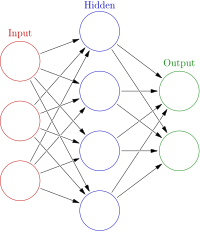
Photo from wikipedia
The prediction of a molecule's solvation Gibbs free (ΔGsolv) energy in a given solvent is an important task which has traditionally been carried out via quantum chemical continuum methods or… Click to show full abstract
The prediction of a molecule's solvation Gibbs free (ΔGsolv) energy in a given solvent is an important task which has traditionally been carried out via quantum chemical continuum methods or force field-based molecular simulations. Machine learning (ML) and graph neural networks in particular have emerged as powerful techniques for elucidating structure-property relationships. This work presents a graph neural network (GNN) for the prediction of ΔGsolv which, in addition to encoding typical atom and bond-level features, incorporates chemically intuitive, solvation-relevant parameters into the featurization process: semiempirical partial atomic charges and solvent dielectric constant. Solute-solvent interactions are included via an interaction map layer which can be visualized to examine solubility-enhancing or -decreasing interactions learnt by the model. On a test set of small organic molecules, our GNN predicts ΔGsolv in water and cyclohexane with an accuracy comparable to polarizable and ab initio generated force field methods [mean absolute error (MAE) = 0.4 and 0.2 kcal mol-1, respectively], without the need for any molecular simulation. For the FreeSolv data set of hydration free energies, the test MAE is 0.7 kcal mol-1. Interpretability and applicability of the model is highlighted through several examples including rationalizing the increased solubility of modified diaminoanthraquinones in organic solvents. The clear explanations afforded by our GNN allow for easy understanding of the model's predictions, giving the experimental chemist confidence in employing ML models toward more optimized synthetic routes.
Journal Title: Journal of chemical information and modeling
Year Published: 2022
Link to full text (if available)
Share on Social Media: Sign Up to like & get
recommendations!